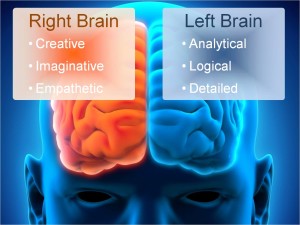Business presentations are about convincing people to make a change. But it’s not easy to convince people to change. This is because our brains are wired to protect us. Since the days of the cave man, we have been focused on surviving and being safe. Fear and worry set off the primitive response area of the brain. This causes our flight, fight, or freeze reaction. The amygdala area of the brain is designed to be a control center for keeping things in balance. When we fear making a change this “brain supervisor” says to you, “Watch out – there could be danger! Don’t make a change something could go wrong. Things will not be the same. It could be good, but it could be dangerous.”
How does this impact decision making? Your customer must overcome their emotional fear of failure or danger. With most presentations and proposals, you are selling to the left side of the brain. Your customer’s left brain is focused on facts and logic. Proposals and presentations provide facts and display charts and graphs with the goal of convincing customers to make a change and buy their product or solution. But the left brain does not make the decision. It’s the right brain that makes the decision and the left brain justifies the decision the right brain has made. The right brain is focused on emotions. It’s creative, imaginative, and empathetic.
 How do you reach the right side of the brain? You reach it with a good story. A good story will not only entertain your customer, it will develop understanding, and teach and inspire the customer to overcome their fear and take action. It’s a non-confrontational way to reach them and encourage them to change. Facts and charts can cause them to dig in their heels and support their view, but a good story can open their mind to new ideas and help them envision success rather than failure or danger.
How do you reach the right side of the brain? You reach it with a good story. A good story will not only entertain your customer, it will develop understanding, and teach and inspire the customer to overcome their fear and take action. It’s a non-confrontational way to reach them and encourage them to change. Facts and charts can cause them to dig in their heels and support their view, but a good story can open their mind to new ideas and help them envision success rather than failure or danger.
Customers don’t want marketing-speak. They want real stories that include details, truth, emotions, and meaning. They know that everything was not rosy from the beginning. Telling the whole story, with its challenges and bumps in the road allows the customer to connect. They’ll see the vision and the hope of what can be with their right brain. When they know that others had trod the rugged path and achieved success, it allays their fears and allows their brain to make the decision and justify what they have decided. It’s similar to the story line in great movies where the hero resists the challenge but the mentor helps him see the vision of what can be and he makes the decision to accept the challenge and achieve success.
Stories are persuasive. Telling good stories can capture the minds and emotions of your prospects and significantly improve your opportunity for a sale.
For more hints and tips visit other posts on our website: www.salestrainingsolutions.com and our eLearning site digiprintacademy.com

